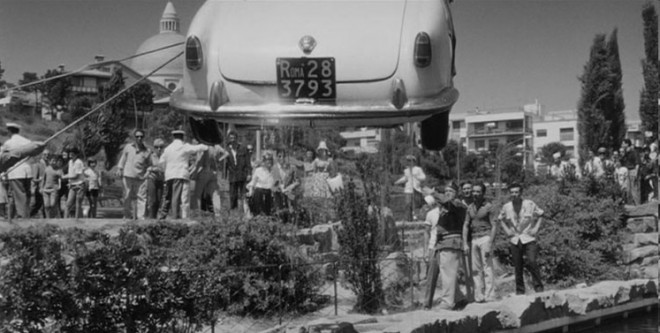Probably the most beautifully composed and shot of all Japanese films, writer-director Keisuke Kinoshita’s elegiac, powerful Nogiku no gotoki kimi nariki is based on a novel by Sachio Ito. Rigorous, intensely evocative (it lacks the free-flowing sentimentality of Kinoshita’s 1954 Twenty-Four Eyes), this jewel resonates on three different levels of import, each deepening the other two while retaining its own solitary existence.
In his seventies, Masao (Chishu Ryu, no less) is being rowed on a river to his long-ago left-behind rural home village. He and the boatman remark on the changes Japan has undergone; Masao notes he had a hard time during the war. He also confesses to having a blurred memory. Yet he is full of memories, which we see in precise form, each time visually launched by Kinoshita’s fixed use of iris frames. (There’s no irising in or out.) But we wonder, due to the inclusion of scenes that must be independent of Masao’s memory, how much is his invention—a way to compensate for indistinct memory and to insist on the “truth” that one may find necessary especially as one nears the end of one’s life. For Masao, the sight, from the boat, of a field of wildflowers either triggers his memories or spurs his imagination to create them—or some elusive blend of both activities. The sound of crickets permeates some of Masao’s—and Kinoshita’s—flashbacks.
Nearly sixty years ago, Masao and his cousin Tamiko (Noriko Arita—for me, worth a thousand Hideko Takamines), when they were 17 and 15, were in love with one another. It was their “first love.” However, the family role that his parents envisioned for him required that Masao sacrifice their romance for the sake of formal education; in his absence when he was away at school, Tamiko was pressured into an arranged marriage. A miscarriage ends her life. The brutality with which his father informs Masao of her death suggests the extent to which the familial denial of the boy’s self-determination in life reflects the political lack of self-determination that the Japanese people suffered more recently in the build-up to and the execution of the Second World War. Finally, mortality—mortal awareness and the encroaching end—is another level of import. Narratively, the film ends with Masao visiting the past by visiting Tamiko’s gravesite. His voiceover, with which the present intermittently punctures the past throughout the film: “Only the crickets sing at her grave.”
A title-screen comprises the closing frames: “She was like a wild chrysanthemum.” The loss of who Masao claims was his only “real love” reflects national Japanese upheaval and Masao’s own impending doom. The river symbolically expresses the fluid fusion of the film’s three levels of meaning, each reflecting each.
Hiroyuki Kusuda won two major awards—Mainichi Film Concours; Blue Ribbon—for his peerless black-and-white cinematography.
B(U)Y THE BOOK
MY BOOK, A Short Chronology of World Cinema, IS CURRENTLY AVAILABLE FROM THE SANDS FILMS CINEMA CLUB IN LONDON. USING EITHER OF THE LINKS BELOW, ACCESS THE ADVERTISEMENT FOR THIS BOOK, FROM WHICH YOU CAN ORDER ONE OR MORE COPIES OF IT. THANKS.
